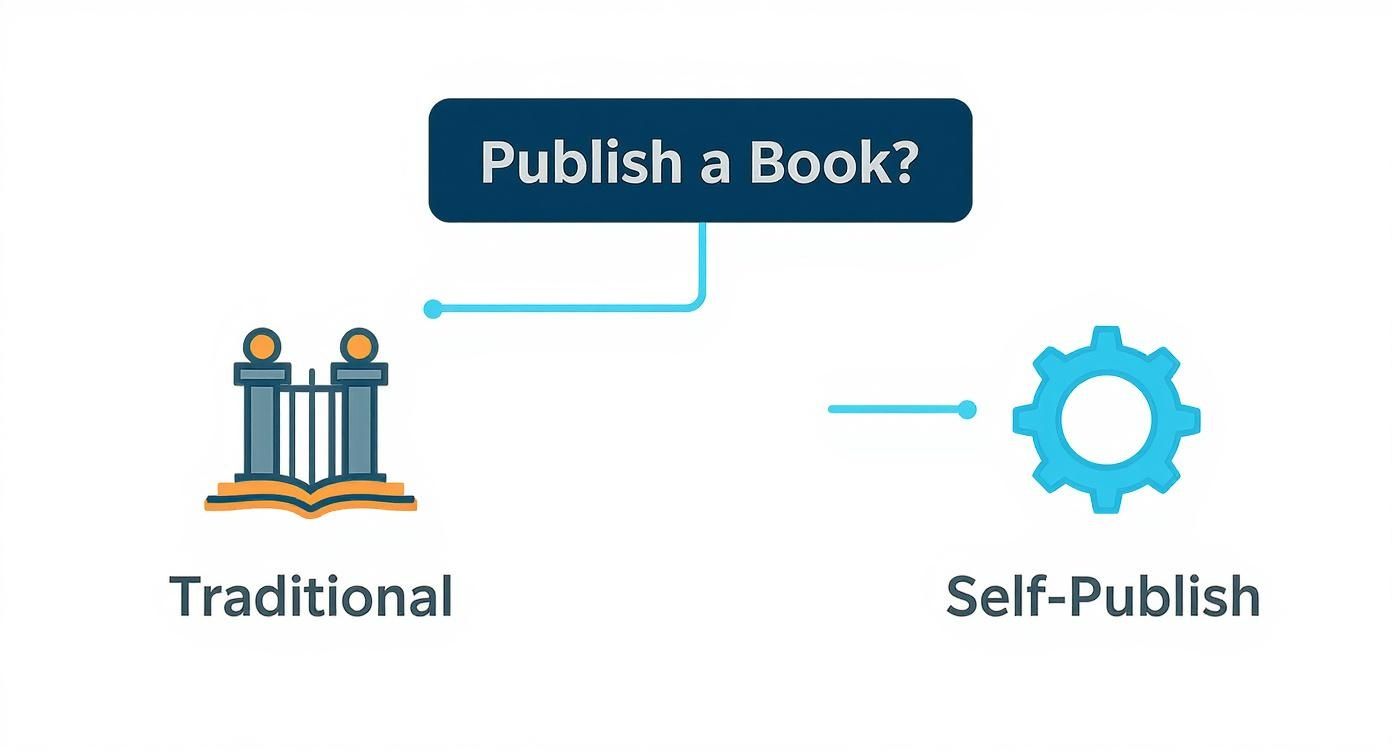So, just how hard is it to publish a book? The real answer is that it's tough, no matter what. But how it's tough depends entirely on which path you take: traditional publishing or self-publishing. Both demand a ton of work, but one is about getting past the gatekeepers, while the other is a true test of your entrepreneurial spirit.
The Two Paths to Getting Your Book Published
Thinking about getting your book published is a bit like planning a massive cross-country road trip. You have two main ways to go about it, and each comes with its own unique set of roadblocks and scenery. Figuring out which route is for you is the first step in understanding the journey ahead.
Traditional Publishing: The Scenic Route with a Guide
The first option is traditional publishing. Think of this as winning a contest for an all-expenses-paid, professionally guided tour. The competition to get picked is fierce, and you'll likely face a mountain of rejection letters before you even get a "maybe."
But if you do get picked up, a whole team of experts jumps in to handle the costs, logistics, and promotion. Your main job, after writing the book, is to convince them you’re worth their investment.
Self-Publishing: The DIY Road Trip
The second option is self-publishing. This is the ultimate DIY road trip. You're the one planning the route, paying for the gas, booking the hotels, and making all the decisions. You have total creative freedom, from the cover design to the final price.
The flip side? You're also the one on the hook for every expense, every task, and all the marketing needed to get people to come along for the ride.
This visual shows how those choices play out on each path.

As you can see, the core difference boils down to control versus validation. Traditional publishing gives you industry validation, but you give up a lot of control. Self-publishing gives you complete control, but you have to fund everything and prove your book's value to the market yourself.
To help you see the trade-offs more clearly, let's break them down side-by-side.
Traditional vs Self-Publishing At a Glance
| Factor | Traditional Publishing | Self-Publishing |
|---|---|---|
| Upfront Cost | Zero. The publisher covers all costs. | High. You pay for everything (editing, design, etc.). |
| Gatekeepers | Many. Must secure an agent and an editor. | None. You decide when and what to publish. |
| Timeline | Very slow. Often 18-24 months from signing to launch. | Fast. You set the pace; can be a few months. |
| Creative Control | Limited. Publisher has final say on title, cover, edits. | Total. You have 100% control over all aspects. |
| Royalties | Lower. Typically 5-15% of net receipts. | Higher. Can be up to 70% (minus printing/distro fees). |
| Distribution | Wide. Built-in access to major bookstores. | Challenging. Primarily online; getting into stores is hard. |
| Marketing | Varies. Publisher support, but author still does a lot. | All on you. You are the marketing department. |
Ultimately, choosing a path means choosing your challenge. If you want a more detailed comparison, you can explore the nuances between traditional vs self-publishing.
The difficulty of publishing isn't a single measure; it's a spectrum. On one end, you have the difficulty of acceptance and patience. On the other, you have the difficulty of investment and execution.
Neither path is the "easy" one—they just present different mountains to climb. The rest of this guide will dig into the specific hurdles you'll face, no matter which route you choose, so you can be ready for the demanding but incredibly rewarding journey ahead.
Navigating the Gauntlet of Traditional Publishing

Dreaming of a traditional publishing deal? Be prepared for a lesson in patience and persistence. When you ask, "how hard is it to publish a book?" this path is where the reality of the industry really hits home. It's a world of gatekeepers, long waits, and fierce competition where your manuscript is one of thousands fighting for a single sliver of attention.
Your first, and arguably biggest, challenge isn't a publisher—it's getting a literary agent. Think of them as the gatekeepers to the major publishing houses. For the most part, if you send your manuscript directly to a big publisher, it’ll land in the "slush pile," likely never to be read. An agent is your ticket in the door.
This means your first real job is learning how to sell your book before it’s even a book. You have to craft the perfect pitch, which is much more than just a quick email. It’s a specific set of documents, and each one needs to be flawless.
The Agent's Gateway: The Query and Proposal
Before an agent even glances at your first chapter, they’re going to judge your entire project on a small package of materials. Getting this right is everything.
- The Query Letter: This is your one-page sales pitch. It has to hook them with your story, briefly introduce who you are, and explain why your book has a place in today's market. It’s an art form in itself.
- The Synopsis: A detailed summary of your entire book—spoilers and all. Agents need to know you can stick the landing and have a solid, well-structured story from start to finish.
- The Book Proposal (for non-fiction): If you're writing non-fiction, this is your business plan. It goes deep, covering a market analysis, your personal promotion plan, chapter-by-chapter outlines, and sample chapters to prove the book is a worthwhile investment.
Just putting these documents together can take months. And it’s not a one-and-done deal; you have to tailor your pitch for every single agent, showing you’ve actually researched who they are and what they represent. After all that work? You wait. And you face a lot of rejection.
Let's be real about the numbers. The global publishing market is huge, but the agents who hold the keys are incredibly selective. Over 90% of the manuscripts they see get rejected. For more on the industry's numbers, you can find some great book sales statistics at Newprint.
Beyond the Pitch: Timelines and Control
So let's say you do it. You beat the odds, land an agent, and they sell your book. The challenges don't stop; they just change. The whole process moves at a glacial pace. It can easily take 18 to 24 months from the day you sign the contract to the day you finally see your book on a shelf.
During that long wait, you'll also have to get comfortable with giving up a good deal of creative control. The publisher's team has the final say on some of the most important aspects of your book's identity.
Here's what you'll likely have to compromise on:
- The Title: They might decide your title isn't commercial enough and change it to something they think will sell better.
- The Cover Design: Their art department will create a cover that fits their marketing strategy, and it may look nothing like what you envisioned.
- Final Edits: Editing is a collaboration, but the publisher's editor can request major changes to the story, characters, or structure.
And here’s the kicker that catches many authors by surprise: even with a deal, the marketing support might be thin. Publishers pour their big budgets into their lead titles—the ones they expect to be bestsellers. Many other authors are left to handle a huge chunk of their own promotion. The dream of a publisher handling everything is, for most, just that: a dream.
The Entrepreneurial Challenge of Self-Publishing
Deciding to self-publish is thrilling. It puts you in complete creative control, but it also instantly turns you from a writer into an entrepreneur. For authors on this path, the question "how hard is it to publish a book?" isn't just about writing—it’s about project management, budgeting, and marketing know-how.
Think of it this way: you’re no longer just the author. You're now the CEO of your book's entire launch. This means you’re personally responsible for funding and managing every single step of the process. The safety net of a traditional publisher is gone, and every decision, risk, and dollar is squarely on your shoulders.
Your New Job Description
Bringing a book to life takes a team of skilled professionals. When you self-publish, you’re the one who has to find, hire, and pay that team. The quality of your finished book will be a direct reflection of the investment you're willing to make in these crucial areas.
Your new to-do list looks something like this:
- Hiring Professional Editors: This one's non-negotiable. You’ll need to find and pay for different editing stages, from developmental editing (which shapes the story) to copy editing (for grammar and style) and a final, meticulous proofread.
- Commissioning a Cover Designer: Your book cover is your single most important marketing asset. You need a professional designer who gets your genre and knows how to create a cover that grabs a reader's attention in a split second.
- Formatting for Every Platform: Your manuscript needs to be flawlessly formatted for ebook stores like Amazon KDP and for print-on-demand services. Each platform has its own tricky technical requirements.
- Wrangling Distribution: You’re in charge of setting up accounts, uploading all the files, crafting compelling book descriptions, and strategically setting your price on every platform you sell on.
Here’s a hard truth about self-publishing: writing the book is often the easy part. The real work starts the moment you type "The End." That’s when you have to pivot from a creative project to a commercial product that can hold its own in a crowded marketplace.
The Financial Realities and Risks
Going it alone means taking on a very real financial risk. With a traditional publisher, you get an advance. In self-publishing, you have to make a significant upfront investment long before you ever see your first royalty payment.
The initial costs for professional editing, cover design, and formatting can quickly add up. A high-quality launch can easily run between $2,000 and $5,000, and sometimes much more, depending on your book's needs and the freelancers you bring on board. And you spend all this with absolutely no guarantee of getting it back.
Once the book is out there, the next massive hurdle is getting anyone to notice it. You're not just competing with a few other books; you're up against millions of titles on Amazon alone. Without a smart marketing plan and a budget to fuel it, even a fantastic, professionally produced book can vanish into obscurity. This is the ultimate test of the author-entrepreneur: creating a great book is only half the battle. You also have to build a business to sell it.
The Unseen Price: Time, Energy, and Emotional Grit

When people ask, "how hard is it to publish a book?" they're usually thinking about the practical steps or the money involved. But the costs that truly catch authors off guard aren't on a spreadsheet—they're measured in time and emotional resilience.
Publishing, whether you go the traditional route or self-publish, is a marathon of patience, anxiety, and vulnerability.
The timeline itself can be a shock. If you're chasing a traditional publishing deal, the journey from signing a contract to seeing your book on a shelf can easily take 18 to 24 months. And that's after you land an agent, a process that can take years of querying and rejections.
Self-publishing is faster, sure, but it's not easy. It trades the long wait for an intense sprint where you become the project manager of your own book launch. Suddenly, you're juggling editors, designers, and marketers, all on a deadline you set yourself. No matter the path, the time commitment is huge.
The Emotional Gauntlet You Have to Run
Beyond the calendar, there's the personal toll. Publishing your work means taking something deeply personal and putting it out there for the world to judge. It's a terrifying, vulnerable act, and the path is littered with emotional roadblocks.
- Facing Rejection: Traditional authors are hit with a tidal wave of "no's" from agents and publishers. Each one can feel like a direct hit to your confidence and your craft.
- The Weight of Doubt: The long silences are breeding grounds for anxiety. You start to question everything: Is the book good enough? Did I choose the right path? Will anyone even read it?
- Bracing for Reviews: Once your book is out, it’s fair game for critics. A single one-star review can feel like a personal attack, easily overshadowing a dozen glowing ones. Developing a thick skin is a survival skill.
Publishing isn't just a business deal; it's a huge emotional investment. The steepest price you'll pay is often the mental and emotional energy it takes to shepherd your book from a private dream into a public reality.
This journey demands an almost stubborn belief in your work. It’s an invisible but very real part of the publishing challenge.
Understanding Timelines and What They Cost You
Getting a handle on the different timelines is key to keeping your sanity. For a deeper dive into what to expect, our guide on how long it takes to publish a book breaks down every stage.
For traditionally published authors, that long wait comes with a massive opportunity cost. Those are years you could have spent building a readership or earning royalties, but instead, you're stuck in publishing purgatory.
For self-publishers, the cost is immediate and financial. Every dollar for editing, cover design, and marketing comes straight from your pocket. It's a significant upfront risk you take long before you see a single sale. This is the hidden math of publishing that every author needs to solve.
Making Your Book Stand Out in a Crowded Market
Getting your book published is a huge achievement, no doubt about it. Whether you go the traditional route or publish it yourself, you’ve accomplished something amazing. But here’s the tough part: that was just the first climb. The real mountain is getting people to actually find and buy your book.
The sheer number of books out there is staggering. Millions of titles are all competing for a finite amount of reader attention, making discoverability the single biggest challenge you'll face. The hard truth is that most books, no matter how well-written or professionally published, sell very few copies.
The Numbers Don't Lie
The global book market is growing, projected to hit $192.12 billion by 2030. But don't let that big number fool you; the competition is growing even faster. North America accounts for over 33% of that market, and publishers there tend to pour their marketing dollars into big-name authors or splashy debuts. That leaves new authors scrambling for visibility.
With fiction making up almost 60% of all sales, the fight for attention is even tougher if you write in a less popular genre. You can dig into more stats about the competitive book market on Grandview Research.
All this competition means hitting a bestseller list is a statistical long shot. The dream of becoming an overnight sensation is, for most of us, just a dream.
The question isn't just "how hard is it to publish a book?" It quickly becomes "how hard is it to sell a book?" And the answer is: it takes a serious, strategic effort that extends far beyond the writing itself.
Redefine What Success Looks Like
Instead of chasing that blockbuster dream, it’s much healthier to rethink what success means to you. For most authors, a far more realistic and rewarding goal is to build a loyal readership over time. This shifts your focus from chasing huge sales numbers to building genuine connections.
Your best tools for this are marketing and your author platform—that direct line you have to your audience through a newsletter, social media, or a blog. In today's market, having a platform isn't optional.
Here are a few core ideas for building that following:
- Find Your People: Who is your ideal reader? Get laser-focused on that specific niche audience and aim all your marketing efforts directly at them.
- Show Up Consistently: Don't just pop in when you have a new book out. Connect with your audience regularly with valuable content, whether that’s behind-the-scenes glimpses, interesting articles, or just starting a conversation.
- Build Your Brand: Your author brand is your reputation. It’s what readers think of when they see your name—your writing style, your personality online, and the ideas you stand for.
At the end of the day, success in this crowded market often comes down to an author's ability to connect with readers. Exploring proven strategies to build your author brand can make all the difference. When you focus on building a sustainable career one reader at a time, you turn an overwhelming challenge into a manageable, long-term journey.
Turning the Publishing Dream Into a Reality

After laying out all the hurdles, you might be thinking, "Wow, publishing a book sounds really hard." And you're right, it is. But "hard" doesn't mean "impossible." It just means you need a smart, strategic game plan.
This isn't about finding shortcuts. It's about working smarter to turn your ambition into an actual, achievable plan. Whether you’re chasing a traditional deal or carving your own path, your success boils down to two things: professionalism and preparation.
For Authors Seeking a Traditional Deal
If you're aiming for a contract with a traditional publisher, your entire strategy is about standing out to the gatekeepers—agents and editors. Your job is to make your manuscript an undeniable choice.
-
Do Your Agent Homework: Don't just shotgun your query letter to every agent you can find. Dig deep. Find the agents who represent books in your specific subgenre and have a track record of success. Then, personalize every single pitch to prove you know who they are and why you're a perfect fit.
-
Polish, Polish, Polish: Your manuscript needs to be as clean as you can possibly get it before it ever lands in an agent's inbox. We're talking multiple rounds of self-editing and, ideally, valuable feedback from trusted beta readers. Agents are looking for a gem, not a rough stone that needs a ton of polishing.
-
Build Your Author Platform Yesterday: Publishers aren't just looking for great writers; they're looking for partners who can help sell the book. Start building your online presence now. Connect with potential readers on social media, start a newsletter, or blog about your topic. Show them you already have an audience waiting.
For the Self-Publishing Authorpreneur
If you're going the indie route, you're not just the author—you're the CEO of your own publishing company. Your success hinges on making savvy business decisions and truly understanding your market.
A great way to keep everything on track is to follow a comprehensive https://barkerbooks.com/self-publishing-checklist/ to make sure no crucial steps get missed, from editing and design all the way through to your launch and marketing.
The bottom line is this: Publishing is a tough business, but you can dramatically stack the odds in your favor with a clear strategy, a professional approach, and a solid understanding of how it all works.
Your first step should be realistic planning. Create a detailed budget that accounts for professional editing, cover design, and marketing. Figure out exactly who your ideal reader is, and then build a marketing plan you can actually stick to.
A huge part of that plan should be a smart content repurposing strategy. This allows you to get the most mileage out of your work by turning key ideas or excerpts from your book into compelling social media posts, blog articles, and other promotional content.
Frequently Asked Questions About Publishing a Book
Once you start digging into publishing, a lot of specific questions pop up. It's a complex world, so let's tackle some of the most common things new authors ask as they try to find the right path for their book.
How Long Does It Take to Publish a Book?
This is a big one, and the answer really depends on which road you take.
If you go the traditional route, you need to pack your patience. From the moment you sign with a literary agent to actually seeing your book on a shelf, you're realistically looking at 2 to 3 years. It’s a marathon, not a sprint.
Self-publishing puts the timeline in your hands, but that doesn't mean it's instant. To do it right—with professional editing, a great cover, proper formatting, and a solid marketing plan—you should budget anywhere from 6 to 12 months.
Do I Need a Literary Agent?
If your dream is to be published by one of the "Big Five" (think Penguin Random House or Simon & Schuster), then yes, an agent is pretty much non-negotiable. They are the gatekeepers of that corner of the industry.
But for self-publishing, you don't need an agent at all. You're the one in charge. There are also many fantastic smaller independent presses and hybrid publishers that accept submissions directly from authors, giving you another way in without needing representation.
The reality is that most authors do not make a full-time living from book sales alone. Success is often a long-term game of building a loyal readership.
How Much Money Can I Expect to Make?
Let's be real: earnings are all over the map. The most important thing is to set realistic expectations.
With a traditional publisher, a debut author might get an advance between $5,000 and $15,000. Many books never "earn out," meaning they don't sell enough copies for the author to receive royalties beyond that initial payment.
For self-published authors, the income spectrum is even wider. A tiny fraction of authors earn a very comfortable living, but the vast majority make very little. Your financial success truly boils down to your genre, how well you market your book, and your ability to build a dedicated audience over time.
At BarkerBooks, we help authors navigate every step of this complex journey. If you're ready to turn your manuscript into a professionally published book with global reach, we have the expertise to make it happen. Learn more about our publishing services and get started today.
